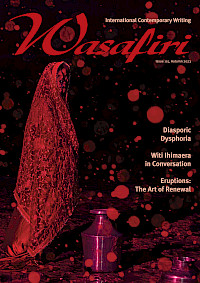Cover photo by cottonbro studio on Pexels
Death, Religion, and Motherhood: An Interview with Claudia Piñeiro
You can read the full interview online or in the print issue of the magazine. You can also read an exclusive extract from Piñeiro's new novel, A Little Luck, translated by Frances Riddle.
Claudia Piñeiro, born in Argentina in 1960, is best known for her literary crime fiction, bestsellers in Argentina, and award-winning novels that put under careful examination society, religious institutions, the media, and political systems. Piñeiro has been awarded the Rosalía de Castro Prize, the Pepe Carvalho Crime Fiction Prize, and the Canadian Blue Metropolis Prize. Elena Knows, translated into English by Frances Riddle (Charco Press, 2021), won the LiBeraturpreis 2010, was shortlisted for the 2022 International Booker Prize, and at the time of writing is shortlisted for the Queen Sofía Spanish Institute QSSI Translation Prize. Other novels of hers available in English with Bitter Lemon Press and translated by Miranda France are Thursday Night Widows, winner of the Clarín Novel Prize; A Crack in the Wall, winner of the Sor Juana Inés de la Cruz Prize; Betty Boo; and All Yours.
In Elena Knows, an elderly woman with Parkinson’s disease is trying to solve the mystery behind her daughter’s death. This is used as a springboard to explore abortion, religious dogma, the bureaucracy of the health system, the burdens of caring for a disabled person, and mother–daughter relationships. If you ask Piñeiro what Elena Knows is about she’d simply say: ‘the body’. The novel centres women whose bodies are subject to external forces: Elena has an ill body, Isabel’s body pregnant against her wishes, and Rita’s is a dead body.
I talked to Claudia Piñeiro on one of her visits to London; we spoke in Spanish and I translated our conversation into English. We discussed her writing process, how crime fiction writes the societies where these crimes take place; death, religion, and motherhood as recurring themes in her writing; and how being Latin American has shaped her work.
Silvia Rothlisberger: You’ve spoken elsewhere about having quite clear images as starting points for your novels: what was the trigger image for Elena Knows?
Claudia Piñeiro: The initial image was this woman in her kitchen waiting for her medicine to have an effect on her so that she could start to walk; that’s what I show in the first chapter. Sometimes the trigger image of a novel appears in the first chapter, sometimes in a different one, and sometimes it doesn’t appear in the novel at all but serves as a catalyst. In this case, it does coincide with the initial image of the novel.
For a long time the title of the novel was The Body of Others because it is about other people having an opinion on your body: from a medical point of view, from a religious one, and even opinions based on prejudices. But that same year that I was writing this novel, a German movie was released: The Lives of Others. I thought ‘Hmmm, it’s very similar’ so I started to look for other titles, and finally I decided to call it Elena Knows, a title that now I like a lot more. But the point is that from the very beginning the novel was totally involved with the body, and in thinking about the body as one’s own property and not someone else’s.
To continue with this image of the woman waiting for her medicine to have an effect, she is a woman who suffers from Parkinson’s disease and the pace of the book evolves around this ill body and the pills she must take for her body to function. What inspired this character and how did you research all the details of the daily life of a person with this condition?
Parkinson’s is an illness that I know very closely because my mother had it. The story of Rita and Elena isn’t the story of me and my mother, but it’s true that I know that kind of ill body; I lived with her until she died so I know the details. Apart from this, I did research about Parkinson’s disease but none of what I read reflected what I had seen. Because they explain the illness, that it can happen to you, et cetera, but they don’t tell you that if you are reading a book your dribble will fall on the book. Or everyday details that are uglier that maybe they prefer not to write about; though it would be better to read about them because then you wouldn’t feel so isolated. There are many things about the day-to-day symptoms that are very disabling for the person. I lived this because I had my mother living in a body like this in my house.
There is an impactful image in the book of Rita’s body hanging from the church belfry after she has, we presume, killed herself. What can you say about this image and about the decision you took as an author for Rita to die this way?
When I started to write Elena Knows I wasn’t sure about what had happened to Rita. I didn’t know if she had killed herself or if someone had killed her.
I was attending the writing workshop of Guillermo Saccomanno. In Argentina it’s very common to attend creative writing workshops because studying literature prepares you for something different, to be a critic or an academic, but not to be a creative writer. Now there are creative writing courses at university level, but there weren’t at that time. Instead, there were creative writing workshops with the most important writers in Argentina and Guillermo Saccomanno led one of them. I was attending his workshop and when I wrote this scene of Rita hanging from the belfry of the church, Saccomanno asked me ‘But why this strange thing of hanging from a belfry, why not take an overdose using the mother’s pills or any other method?’. And first I thought, I don’t know if medication for Parkinson’s could kill her. But what he didn’t know was that in my childhood I lived in a village called Burzaco, forty kilometres south from Buenos Aires, and in that town, when I was a child, we all knew each other, though now it’s bigger. And I saw on three different occasions dead people being taken down from the church’s belfry. Because if you wanted to kill yourself in Burzaco, which had a population with very low income and where it wasn’t common to own a gun, people’s options were to throw themselves under the train (I also saw people being taken out from under the train) or you would hang yourself from the church’s belfry. So for me it was normal, it wasn’t something strange like it was to him [Saccomanno]. I then told a friend that I was writing a novel about a woman whose daughter is found hanging from the church’s belfry and my friend instantly replied ‘Ah! Your novel is located in Burzaco?' ...
Continue reading the full piece online or in Wasafiri 115


